recommended oil FORD F650/750 2024 Owners Manual
[x] Cancel search | Manufacturer: FORD, Model Year: 2024, Model line: F650/750, Model: FORD F650/750 2024Pages: 386, PDF Size: 8.7 MB
Page 12 of 386
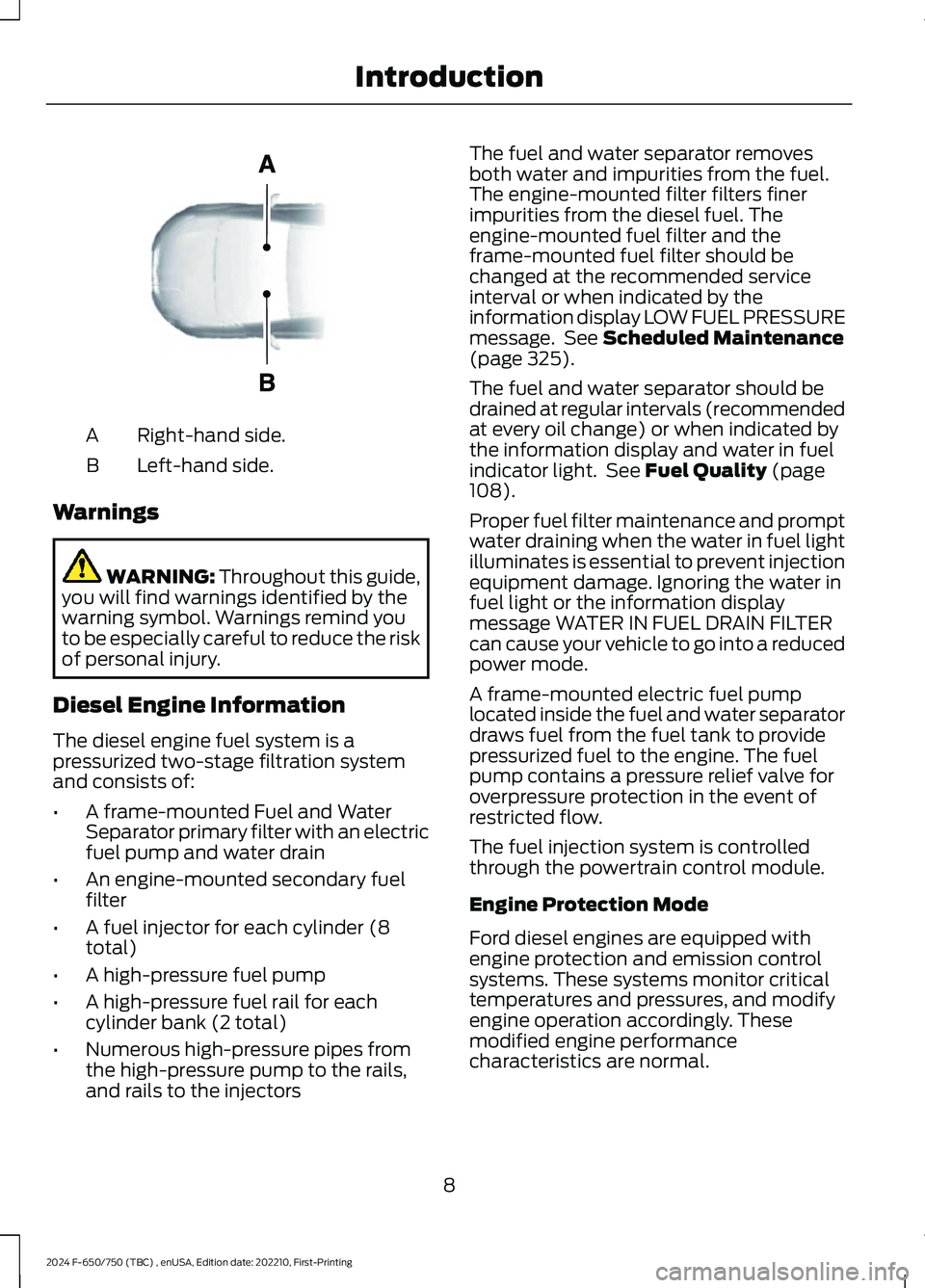
Right-hand side.A
Left-hand side.B
Warnings
WARNING: Throughout this guide,you will find warnings identified by thewarning symbol. Warnings remind youto be especially careful to reduce the riskof personal injury.
Diesel Engine Information
The diesel engine fuel system is apressurized two-stage filtration systemand consists of:
•A frame-mounted Fuel and WaterSeparator primary filter with an electricfuel pump and water drain
•An engine-mounted secondary fuelfilter
•A fuel injector for each cylinder (8total)
•A high-pressure fuel pump
•A high-pressure fuel rail for eachcylinder bank (2 total)
•Numerous high-pressure pipes fromthe high-pressure pump to the rails,and rails to the injectors
The fuel and water separator removesboth water and impurities from the fuel.The engine-mounted filter filters finerimpurities from the diesel fuel. Theengine-mounted fuel filter and theframe-mounted fuel filter should bechanged at the recommended serviceinterval or when indicated by theinformation display LOW FUEL PRESSUREmessage. See Scheduled Maintenance(page 325).
The fuel and water separator should bedrained at regular intervals (recommendedat every oil change) or when indicated bythe information display and water in fuelindicator light. See Fuel Quality (page108).
Proper fuel filter maintenance and promptwater draining when the water in fuel lightilluminates is essential to prevent injectionequipment damage. Ignoring the water infuel light or the information displaymessage WATER IN FUEL DRAIN FILTERcan cause your vehicle to go into a reducedpower mode.
A frame-mounted electric fuel pumplocated inside the fuel and water separatordraws fuel from the fuel tank to providepressurized fuel to the engine. The fuelpump contains a pressure relief valve foroverpressure protection in the event ofrestricted flow.
The fuel injection system is controlledthrough the powertrain control module.
Engine Protection Mode
Ford diesel engines are equipped withengine protection and emission controlsystems. These systems monitor criticaltemperatures and pressures, and modifyengine operation accordingly. Thesemodified engine performancecharacteristics are normal.
8
2024 F-650/750 (TBC) , enUSA, Edition date: 202210, First-PrintingIntroductionE154903
Page 13 of 386

If these modified engine performancecharacteristics persist for an extendedperiod and either the service engine soonor powertrain malfunction, reduced power,electronic throttle control light isilluminated, have the system checked byan authorized dealer.
Service engine soon
Powertrain malfunction, reducedpower, electronic throttle control
Diesel Lubrication System
It is important to change the engine oil atthe recommended service intervals orwhen indicated by the information displayto maintain oil viscosity. Extending the oiland filter change interval beyond therecommended interval can negativelyaffect engine performance, fuel economyand engine life. See Engine Oil Check(page 227).
Engine and secondary cooling system
The cooling system contains a primarycooling loop to cool the engine and asecondary cooling loop to cool thetransmission, charge air, and fuel. Thecoolant serves three primary purposes: toprovide heat transfer, freeze pointprotection, and corrosion protection usingadditives.
Vehicles with diesel engines typically areused to carry heavy loads and accumulatemileage rapidly. These two factors maycause the additives in the coolant to wearout in a shorter time. You can find moreinformation about coolant additives andcoolant change intervals in the coolantchapter. See General MaintenanceInformation (page 325). Operating theengine with insufficient coolant or coolantadditive can cause severe engine damage.
Selective catalytic reduction system
Your vehicle is equipped with a selectivecatalytic reduction system designed toreduce emission levels of nitrogen oxidesfrom the exhaust of your diesel engine. Thissystem relies on the use of Diesel ExhaustFluid (DEF) that you must replenish atcertain intervals. Failure to maintain properDEF levels or if the DEF becomescontaminated will result in vehicle speedlimitations or result in your vehicle enteringan idle-only mode. See SelectiveCatalytic Reductant System (page 120).
Minor Troubleshooting Guide
If the engine won’t crank
WARNING: Battery posts,terminals and related accessoriescontain lead and lead compounds. Washhands after handling.
Turn on the headlights. If the lights are dim,do not go on at all or when the ignition isturned to the start position, the lightsbecome dim or go out, the batteryconnections may be loose or corroded, orthe battery may be discharged. If there isa clicking or stuttering sound coming fromthe engine compartment when you turnthe key to the start position, this may alsoindicate a loose or corroded batteryconnection.
Check the battery connections at thebattery posts, cable connection to theengine grounding point and at the starterconnection.
If you suspect a discharged battery, haveit checked and corrected.
9
2024 F-650/750 (TBC) , enUSA, Edition date: 202210, First-PrintingIntroductionE67028
Page 26 of 386
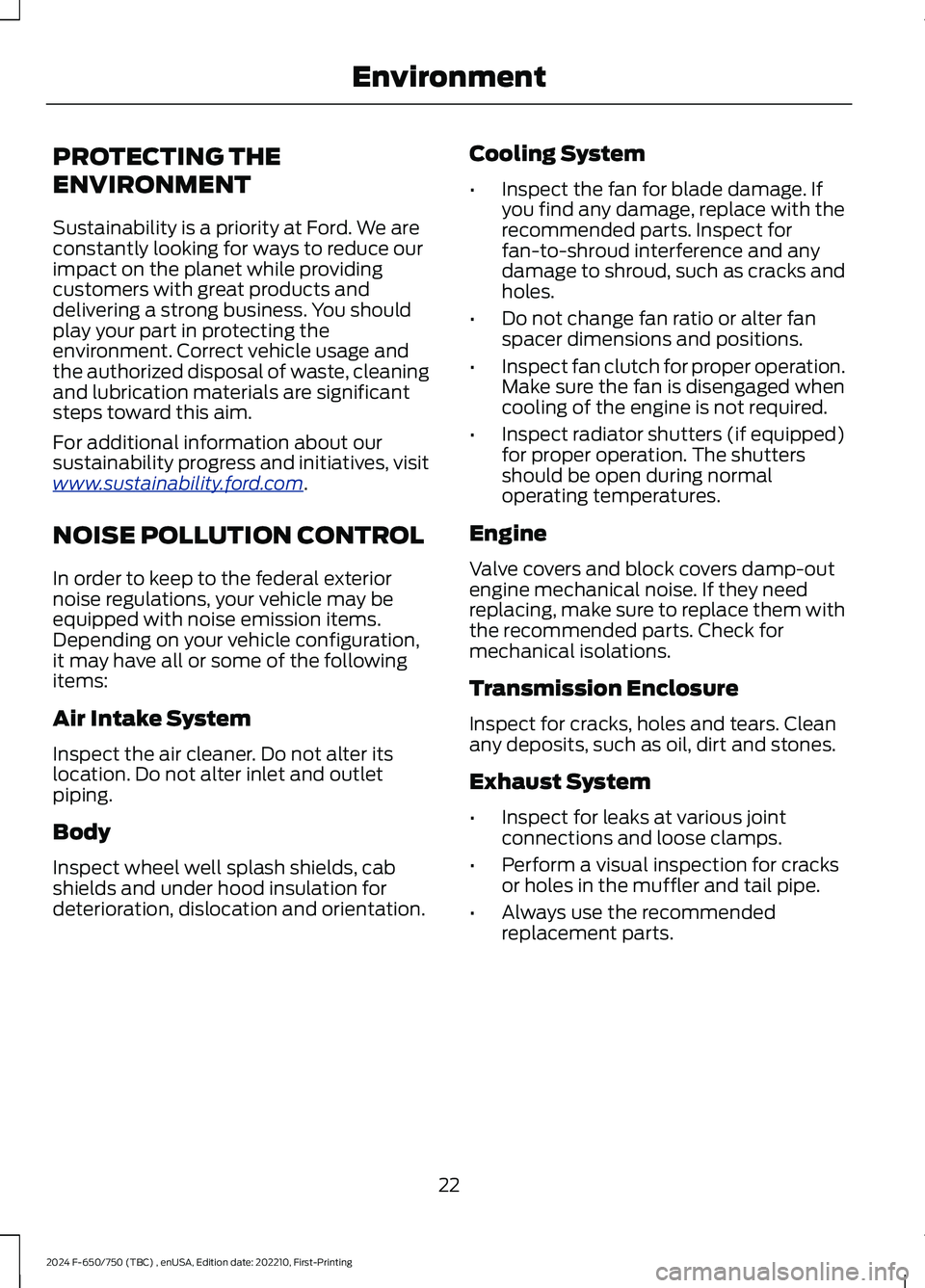
PROTECTING THE
ENVIRONMENT
Sustainability is a priority at Ford. We areconstantly looking for ways to reduce ourimpact on the planet while providingcustomers with great products anddelivering a strong business. You shouldplay your part in protecting theenvironment. Correct vehicle usage andthe authorized disposal of waste, cleaningand lubrication materials are significantsteps toward this aim.
For additional information about oursustainability progress and initiatives, visitwww.sustainability.ford.com.
NOISE POLLUTION CONTROL
In order to keep to the federal exteriornoise regulations, your vehicle may beequipped with noise emission items.Depending on your vehicle configuration,it may have all or some of the followingitems:
Air Intake System
Inspect the air cleaner. Do not alter itslocation. Do not alter inlet and outletpiping.
Body
Inspect wheel well splash shields, cabshields and under hood insulation fordeterioration, dislocation and orientation.
Cooling System
•Inspect the fan for blade damage. Ifyou find any damage, replace with therecommended parts. Inspect forfan-to-shroud interference and anydamage to shroud, such as cracks andholes.
•Do not change fan ratio or alter fanspacer dimensions and positions.
•Inspect fan clutch for proper operation.Make sure the fan is disengaged whencooling of the engine is not required.
•Inspect radiator shutters (if equipped)for proper operation. The shuttersshould be open during normaloperating temperatures.
Engine
Valve covers and block covers damp-outengine mechanical noise. If they needreplacing, make sure to replace them withthe recommended parts. Check formechanical isolations.
Transmission Enclosure
Inspect for cracks, holes and tears. Cleanany deposits, such as oil, dirt and stones.
Exhaust System
•Inspect for leaks at various jointconnections and loose clamps.
•Perform a visual inspection for cracksor holes in the muffler and tail pipe.
•Always use the recommendedreplacement parts.
22
2024 F-650/750 (TBC) , enUSA, Edition date: 202210, First-PrintingEnvironment
Page 105 of 386

GENERAL INFORMATION
WARNING: Extended idling at highengine speeds can produce very hightemperatures in the engine and exhaustsystem, creating the risk of fire or otherdamage.
WARNING: Do not park, idle ordrive your vehicle on dry grass or otherdry ground cover. The emission systemheats up the engine compartment andexhaust system, creating the risk of fire.
WARNING: Do not start the enginein a closed garage or in other enclosedareas. Exhaust fumes are toxic. Alwaysopen the garage door before you startthe engine. Failure to follow thisinstruction could result in personal injuryor death.
WARNING: Exhaust leaks mayresult in entry of harmful and potentiallylethal fumes into the passengercompartment. If you smell exhaustfumes inside your vehicle, have yourvehicle inspected immediately. Do notdrive if you smell exhaust fumes.
The powertrain control system meets allCanadian interference-causing equipmentstandard requirements regulating theimpulse electrical field or radio noise.
Note:If you use your vehicle regularly abovethe altitude of 7,500 ft (2,286 m) and underthe temperature of -4.0°F (-20°C), it isrecommended to use the alternative engineoil. See Capacities and Specifications(page 291).
If you disconnect the battery, your vehiclecould exhibit some unusual drivingcharacteristics for approximately 5 mi(8 km) after you reconnect it. This isbecause the engine management systemmust realign itself with the engine. You candisregard any unusual drivingcharacteristics during this period.
When you start the engine, avoid pressingthe accelerator pedal before and duringoperation.
If you operate your vehicle in a heavy snowstorm or blowing snow conditions, theengine air induction could become partiallyclogged with snow and ice. If this occurs,the engine could experience a significantreduction in power output. At the earliestopportunity, clear all the snow and iceaway from the air induction inlet.
IGNITION SWITCH
0 (off) - The ignition is off.
101
2024 F-650/750 (TBC) , enUSA, Edition date: 202210, First-PrintingStarting and Stopping the Engine0//////E252522
Page 113 of 386
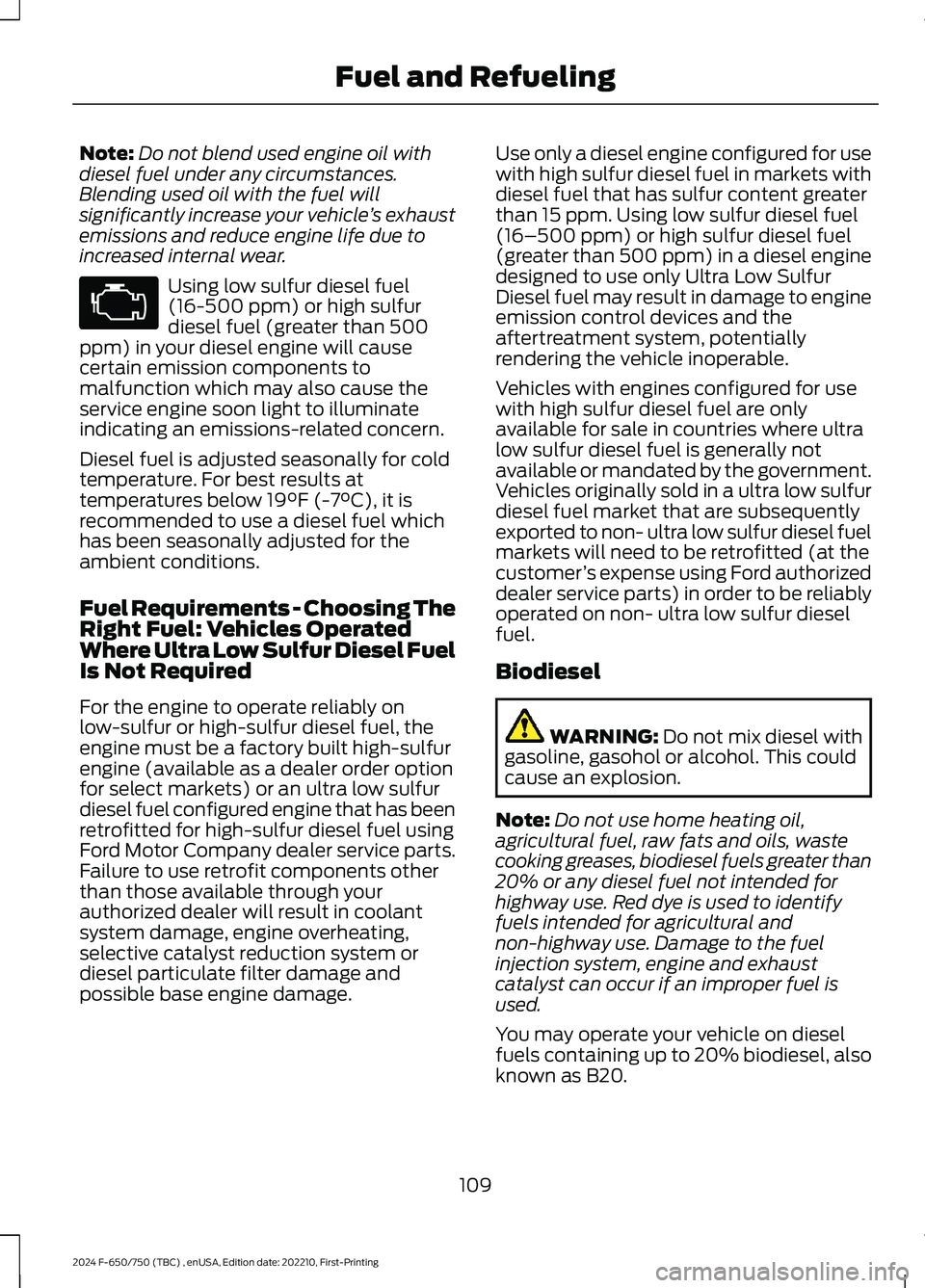
Note:Do not blend used engine oil withdiesel fuel under any circumstances.Blending used oil with the fuel willsignificantly increase your vehicle’s exhaustemissions and reduce engine life due toincreased internal wear.
Using low sulfur diesel fuel(16-500 ppm) or high sulfurdiesel fuel (greater than 500ppm) in your diesel engine will causecertain emission components tomalfunction which may also cause theservice engine soon light to illuminateindicating an emissions-related concern.
Diesel fuel is adjusted seasonally for coldtemperature. For best results attemperatures below 19°F (-7°C), it isrecommended to use a diesel fuel whichhas been seasonally adjusted for theambient conditions.
Fuel Requirements - Choosing TheRight Fuel: Vehicles OperatedWhere Ultra Low Sulfur Diesel FuelIs Not Required
For the engine to operate reliably onlow-sulfur or high-sulfur diesel fuel, theengine must be a factory built high-sulfurengine (available as a dealer order optionfor select markets) or an ultra low sulfurdiesel fuel configured engine that has beenretrofitted for high-sulfur diesel fuel usingFord Motor Company dealer service parts.Failure to use retrofit components otherthan those available through yourauthorized dealer will result in coolantsystem damage, engine overheating,selective catalyst reduction system ordiesel particulate filter damage andpossible base engine damage.
Use only a diesel engine configured for usewith high sulfur diesel fuel in markets withdiesel fuel that has sulfur content greaterthan 15 ppm. Using low sulfur diesel fuel(16–500 ppm) or high sulfur diesel fuel(greater than 500 ppm) in a diesel enginedesigned to use only Ultra Low SulfurDiesel fuel may result in damage to engineemission control devices and theaftertreatment system, potentiallyrendering the vehicle inoperable.
Vehicles with engines configured for usewith high sulfur diesel fuel are onlyavailable for sale in countries where ultralow sulfur diesel fuel is generally notavailable or mandated by the government.Vehicles originally sold in a ultra low sulfurdiesel fuel market that are subsequentlyexported to non- ultra low sulfur diesel fuelmarkets will need to be retrofitted (at thecustomer’s expense using Ford authorizeddealer service parts) in order to be reliablyoperated on non- ultra low sulfur dieselfuel.
Biodiesel
WARNING: Do not mix diesel withgasoline, gasohol or alcohol. This couldcause an explosion.
Note:Do not use home heating oil,agricultural fuel, raw fats and oils, wastecooking greases, biodiesel fuels greater than20% or any diesel fuel not intended forhighway use. Red dye is used to identifyfuels intended for agricultural andnon-highway use. Damage to the fuelinjection system, engine and exhaustcatalyst can occur if an improper fuel isused.
You may operate your vehicle on dieselfuels containing up to 20% biodiesel, alsoknown as B20.
109
2024 F-650/750 (TBC) , enUSA, Edition date: 202210, First-PrintingFuel and RefuelingE67028
Page 114 of 386
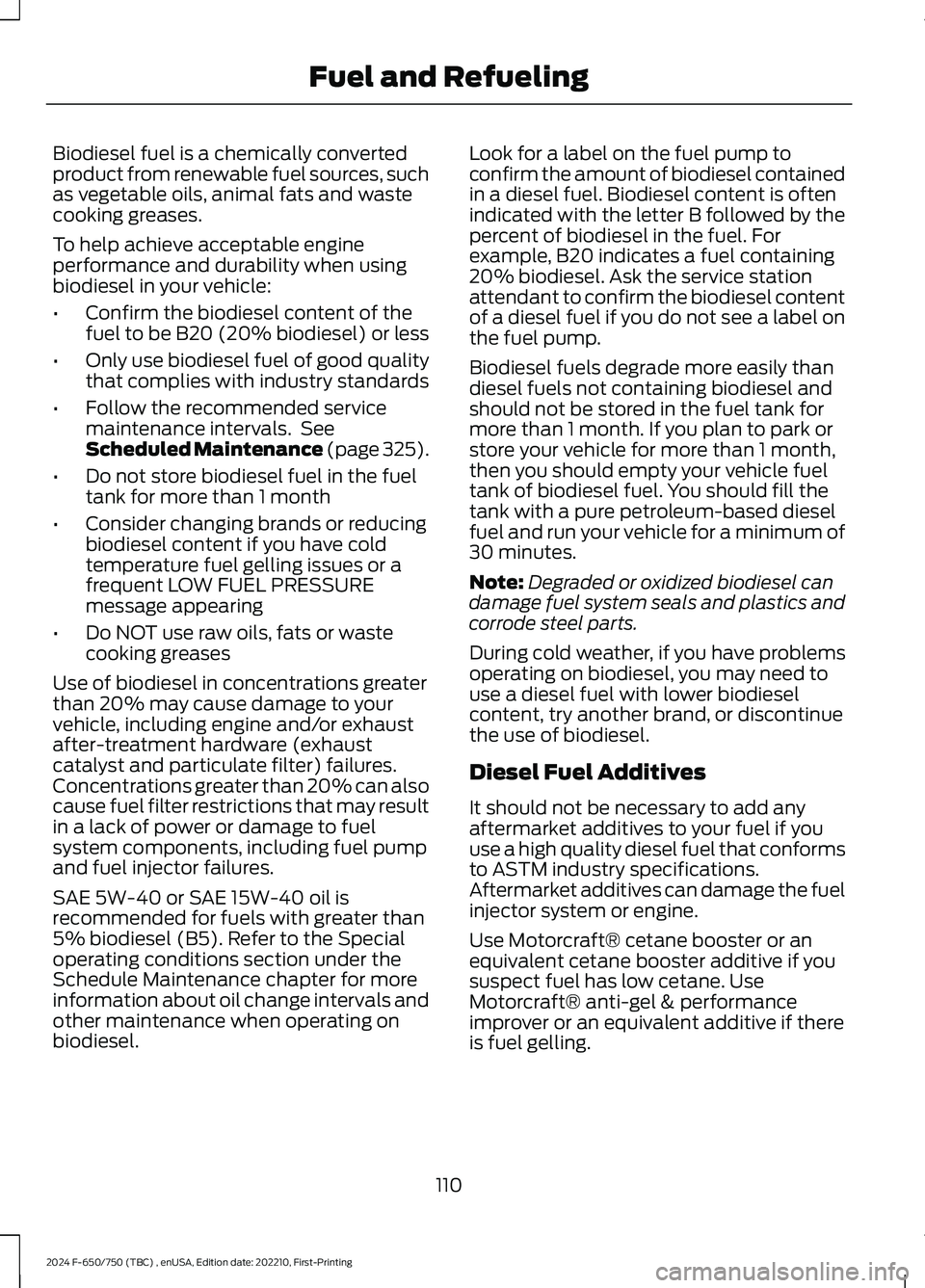
Biodiesel fuel is a chemically convertedproduct from renewable fuel sources, suchas vegetable oils, animal fats and wastecooking greases.
To help achieve acceptable engineperformance and durability when usingbiodiesel in your vehicle:
•Confirm the biodiesel content of thefuel to be B20 (20% biodiesel) or less
•Only use biodiesel fuel of good qualitythat complies with industry standards
•Follow the recommended servicemaintenance intervals. SeeScheduled Maintenance (page 325).
•Do not store biodiesel fuel in the fueltank for more than 1 month
•Consider changing brands or reducingbiodiesel content if you have coldtemperature fuel gelling issues or afrequent LOW FUEL PRESSUREmessage appearing
•Do NOT use raw oils, fats or wastecooking greases
Use of biodiesel in concentrations greaterthan 20% may cause damage to yourvehicle, including engine and/or exhaustafter-treatment hardware (exhaustcatalyst and particulate filter) failures.Concentrations greater than 20% can alsocause fuel filter restrictions that may resultin a lack of power or damage to fuelsystem components, including fuel pumpand fuel injector failures.
SAE 5W-40 or SAE 15W-40 oil isrecommended for fuels with greater than5% biodiesel (B5). Refer to the Specialoperating conditions section under theSchedule Maintenance chapter for moreinformation about oil change intervals andother maintenance when operating onbiodiesel.
Look for a label on the fuel pump toconfirm the amount of biodiesel containedin a diesel fuel. Biodiesel content is oftenindicated with the letter B followed by thepercent of biodiesel in the fuel. Forexample, B20 indicates a fuel containing20% biodiesel. Ask the service stationattendant to confirm the biodiesel contentof a diesel fuel if you do not see a label onthe fuel pump.
Biodiesel fuels degrade more easily thandiesel fuels not containing biodiesel andshould not be stored in the fuel tank formore than 1 month. If you plan to park orstore your vehicle for more than 1 month,then you should empty your vehicle fueltank of biodiesel fuel. You should fill thetank with a pure petroleum-based dieselfuel and run your vehicle for a minimum of30 minutes.
Note:Degraded or oxidized biodiesel candamage fuel system seals and plastics andcorrode steel parts.
During cold weather, if you have problemsoperating on biodiesel, you may need touse a diesel fuel with lower biodieselcontent, try another brand, or discontinuethe use of biodiesel.
Diesel Fuel Additives
It should not be necessary to add anyaftermarket additives to your fuel if youuse a high quality diesel fuel that conformsto ASTM industry specifications.Aftermarket additives can damage the fuelinjector system or engine.
Use Motorcraft® cetane booster or anequivalent cetane booster additive if yoususpect fuel has low cetane. UseMotorcraft® anti-gel & performanceimprover or an equivalent additive if thereis fuel gelling.
110
2024 F-650/750 (TBC) , enUSA, Edition date: 202210, First-PrintingFuel and Refueling
Page 191 of 386
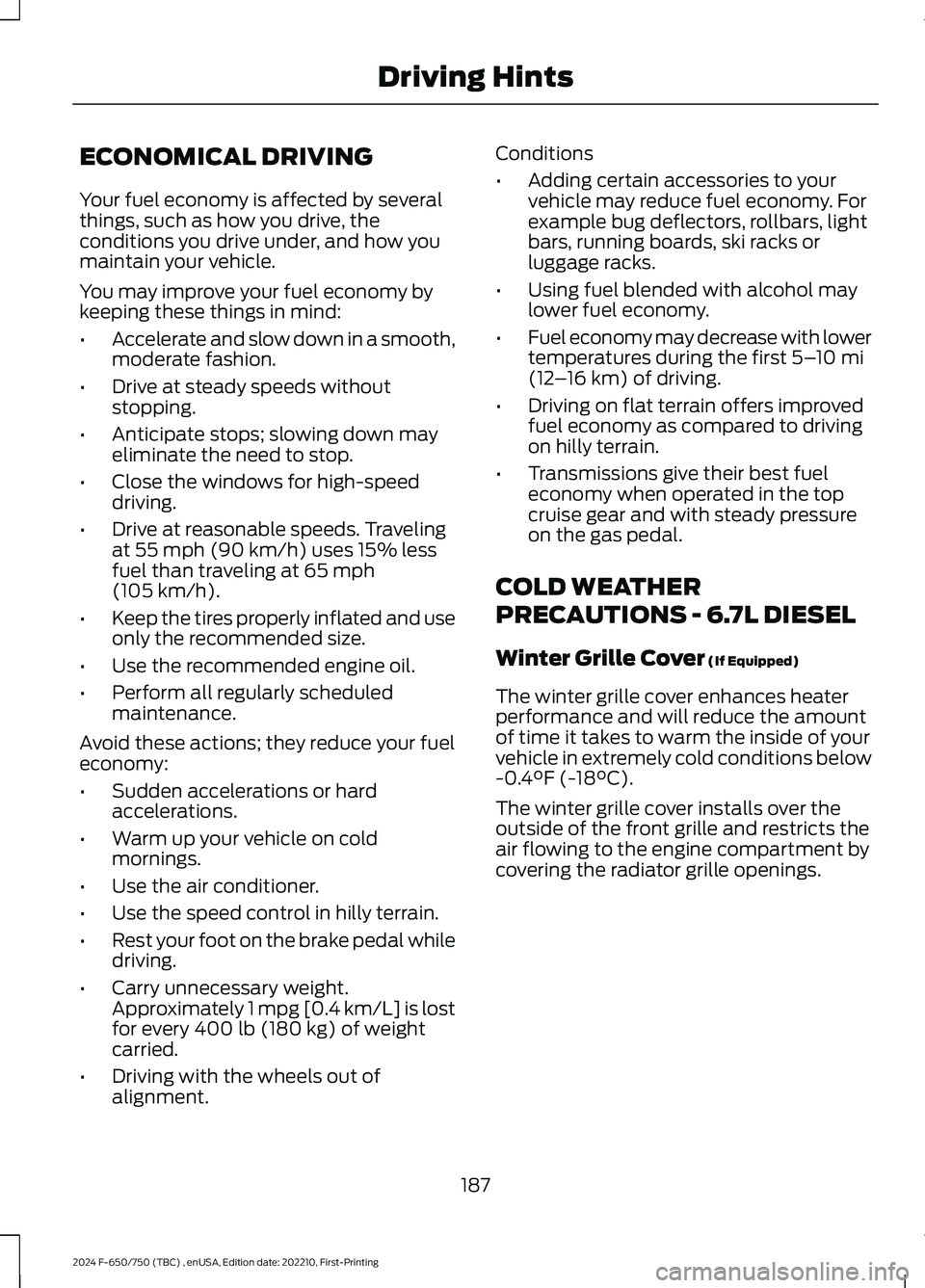
ECONOMICAL DRIVING
Your fuel economy is affected by severalthings, such as how you drive, theconditions you drive under, and how youmaintain your vehicle.
You may improve your fuel economy bykeeping these things in mind:
•Accelerate and slow down in a smooth,moderate fashion.
•Drive at steady speeds withoutstopping.
•Anticipate stops; slowing down mayeliminate the need to stop.
•Close the windows for high-speeddriving.
•Drive at reasonable speeds. Travelingat 55 mph (90 km/h) uses 15% lessfuel than traveling at 65 mph(105 km/h).
•Keep the tires properly inflated and useonly the recommended size.
•Use the recommended engine oil.
•Perform all regularly scheduledmaintenance.
Avoid these actions; they reduce your fueleconomy:
•Sudden accelerations or hardaccelerations.
•Warm up your vehicle on coldmornings.
•Use the air conditioner.
•Use the speed control in hilly terrain.
•Rest your foot on the brake pedal whiledriving.
•Carry unnecessary weight.Approximately 1 mpg [0.4 km/L] is lostfor every 400 lb (180 kg) of weightcarried.
•Driving with the wheels out ofalignment.
Conditions
•Adding certain accessories to yourvehicle may reduce fuel economy. Forexample bug deflectors, rollbars, lightbars, running boards, ski racks orluggage racks.
•Using fuel blended with alcohol maylower fuel economy.
•Fuel economy may decrease with lowertemperatures during the first 5–10 mi(12–16 km) of driving.
•Driving on flat terrain offers improvedfuel economy as compared to drivingon hilly terrain.
•Transmissions give their best fueleconomy when operated in the topcruise gear and with steady pressureon the gas pedal.
COLD WEATHER
PRECAUTIONS - 6.7L DIESEL
Winter Grille Cover (If Equipped)
The winter grille cover enhances heaterperformance and will reduce the amountof time it takes to warm the inside of yourvehicle in extremely cold conditions below-0.4°F (-18°C).
The winter grille cover installs over theoutside of the front grille and restricts theair flowing to the engine compartment bycovering the radiator grille openings.
187
2024 F-650/750 (TBC) , enUSA, Edition date: 202210, First-PrintingDriving Hints
Page 252 of 386
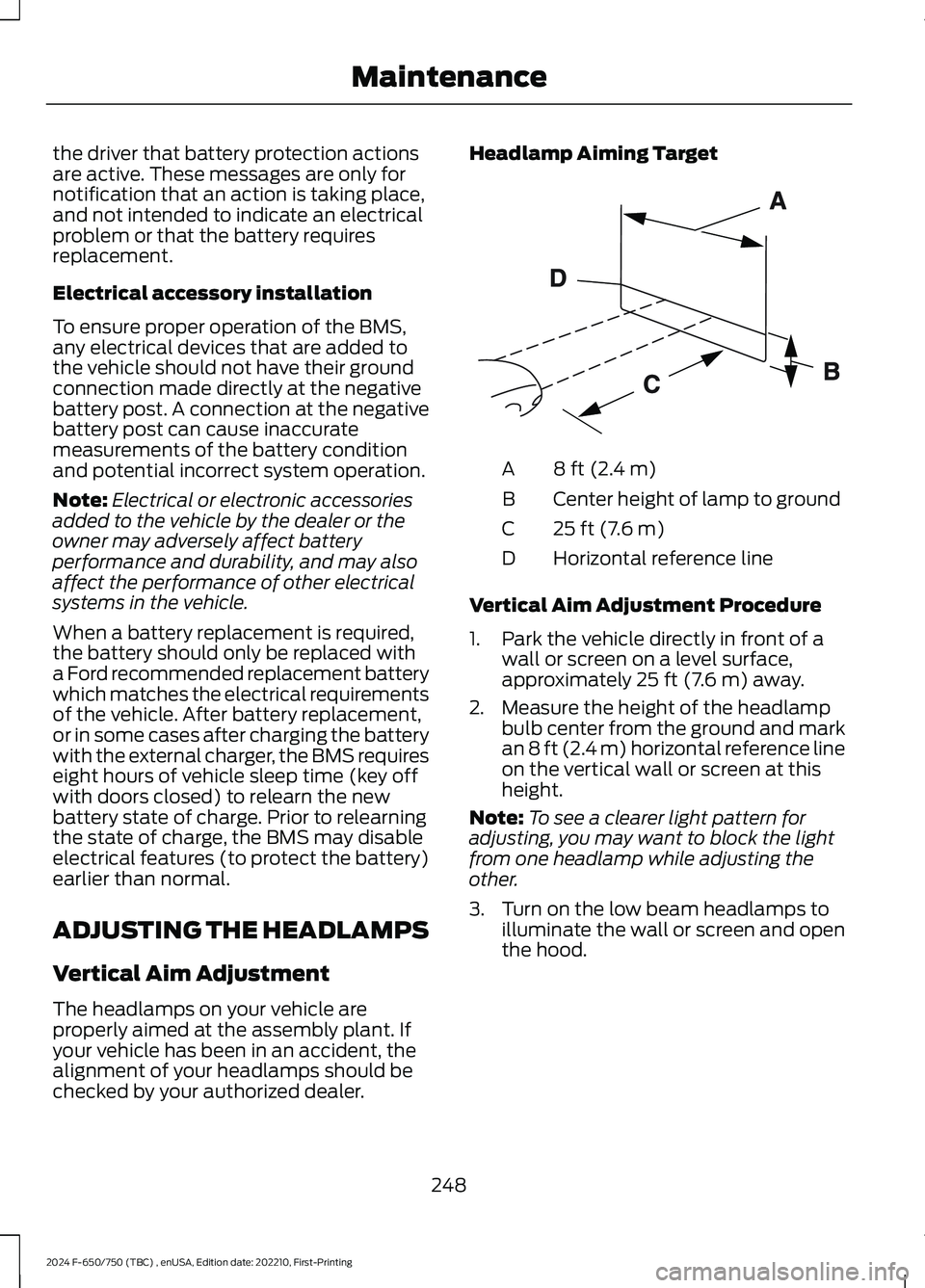
the driver that battery protection actionsare active. These messages are only fornotification that an action is taking place,and not intended to indicate an electricalproblem or that the battery requiresreplacement.
Electrical accessory installation
To ensure proper operation of the BMS,any electrical devices that are added tothe vehicle should not have their groundconnection made directly at the negativebattery post. A connection at the negativebattery post can cause inaccuratemeasurements of the battery conditionand potential incorrect system operation.
Note:Electrical or electronic accessoriesadded to the vehicle by the dealer or theowner may adversely affect batteryperformance and durability, and may alsoaffect the performance of other electricalsystems in the vehicle.
When a battery replacement is required,the battery should only be replaced witha Ford recommended replacement batterywhich matches the electrical requirementsof the vehicle. After battery replacement,or in some cases after charging the batterywith the external charger, the BMS requireseight hours of vehicle sleep time (key offwith doors closed) to relearn the newbattery state of charge. Prior to relearningthe state of charge, the BMS may disableelectrical features (to protect the battery)earlier than normal.
ADJUSTING THE HEADLAMPS
Vertical Aim Adjustment
The headlamps on your vehicle areproperly aimed at the assembly plant. Ifyour vehicle has been in an accident, thealignment of your headlamps should bechecked by your authorized dealer.
Headlamp Aiming Target
8 ft (2.4 m)A
Center height of lamp to groundB
25 ft (7.6 m)C
Horizontal reference lineD
Vertical Aim Adjustment Procedure
1.Park the vehicle directly in front of awall or screen on a level surface,approximately 25 ft (7.6 m) away.
2.Measure the height of the headlampbulb center from the ground and markan 8 ft (2.4 m) horizontal reference lineon the vertical wall or screen at thisheight.
Note:To see a clearer light pattern foradjusting, you may want to block the lightfrom one headlamp while adjusting theother.
3.Turn on the low beam headlamps toilluminate the wall or screen and openthe hood.
248
2024 F-650/750 (TBC) , enUSA, Edition date: 202210, First-PrintingMaintenanceE142592
Page 271 of 386

3.Remove tar and grease with a bug andtar remover. We recommend that youuse Ford approved bug and tar removerif available.
4.Thoroughly rinse the wheels with waterafter cleaning.
If you intend on parking your vehicle for anextended period after cleaning the wheelswith a wheel cleaner, drive your vehicle fora few minutes before doing so. Thisreduces the risk of corrosion of the brakediscs, brake pads and linings.
Do not clean the wheels when they are hot.
Note: Some car washes could damagewheel rims and covers.
Note: Using non-recommended cleaners,harsh cleaning products, chrome wheelcleaners or abrasive materials coulddamage wheel rims, covers and bolts.
VEHICLE STORAGE
If you plan on storing your vehicle for 30days or more, read the followingmaintenance recommendations to makesure your vehicle stays in good operatingcondition.
We engineer and test all motor vehiclesand their components for reliable, regulardriving. Under various conditions,long-term storage may lead to degradedengine performance or failure unless youuse specific precautions to preserve enginecomponents.
General
•Store all vehicles in a dry, ventilatedplace.
•Protect from sunlight, if possible.
•If vehicles are stored outside, theyrequire regular maintenance to protectagainst rust and damage.
Body
•Wash your vehicle thoroughly toremove dirt, grease, oil, tar or mud fromexterior surfaces, rear-wheel housingand the underside of front fenders.
•Periodically wash your vehicle if it isstored in exposed locations.
•Touch-up exposed or primed metal toprevent rust.
•Cover chrome and stainless steel partswith a thick coat of auto wax to preventdiscoloration. Re-wax as necessarywhen you wash your vehicle.
•Lubricate all hood, door and luggagecompartment hinges and latches witha light grade oil.
•Cover interior trim to prevent fading.
•Keep all rubber parts free from oil andsolvents.
Engine
•Change the engine oil and filter prior tostorage because used engine oilcontains contaminates which maycause engine damage.
•Start the engine every 15 days for aminimum of 15 minutes. Run at fastidle with the climate controls set todefrost until the engine reaches normaloperating temperature.
•With your foot on the brake, shiftthrough all the gears while the engineis running.
•We recommend that you change theengine oil before you use your vehicleagain.
Fuel system
•Fill the fuel tank with high-quality fueluntil the first automatic shutoff of thefuel pump nozzle.
267
2024 F-650/750 (TBC) , enUSA, Edition date: 202210, First-PrintingVehicle Care
Page 272 of 386
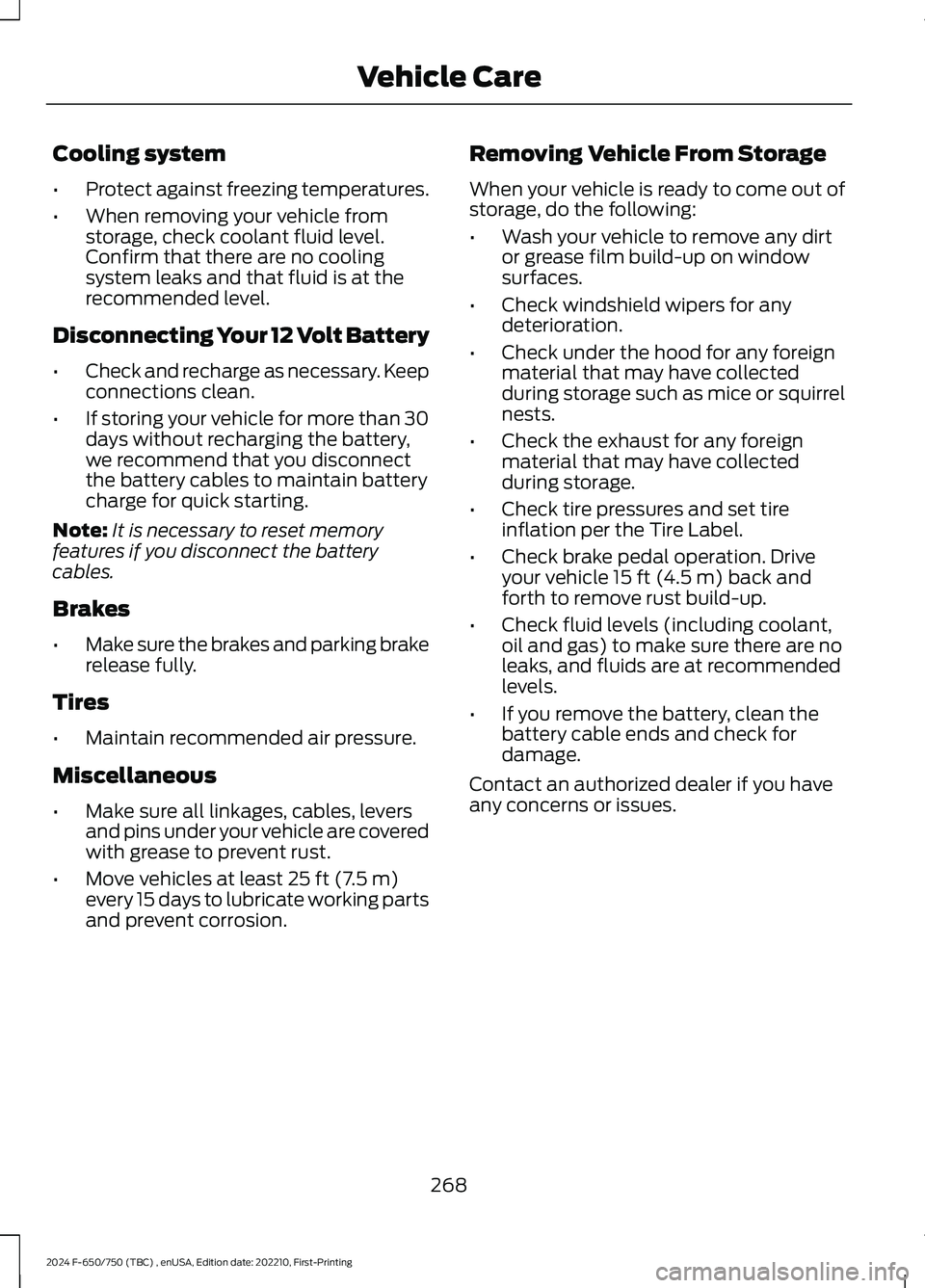
Cooling system
•Protect against freezing temperatures.
•When removing your vehicle fromstorage, check coolant fluid level.Confirm that there are no coolingsystem leaks and that fluid is at therecommended level.
Disconnecting Your 12 Volt Battery
•Check and recharge as necessary. Keepconnections clean.
•If storing your vehicle for more than 30days without recharging the battery,we recommend that you disconnectthe battery cables to maintain batterycharge for quick starting.
Note:It is necessary to reset memoryfeatures if you disconnect the batterycables.
Brakes
•Make sure the brakes and parking brakerelease fully.
Tires
•Maintain recommended air pressure.
Miscellaneous
•Make sure all linkages, cables, leversand pins under your vehicle are coveredwith grease to prevent rust.
•Move vehicles at least 25 ft (7.5 m)every 15 days to lubricate working partsand prevent corrosion.
Removing Vehicle From Storage
When your vehicle is ready to come out ofstorage, do the following:
•Wash your vehicle to remove any dirtor grease film build-up on windowsurfaces.
•Check windshield wipers for anydeterioration.
•Check under the hood for any foreignmaterial that may have collectedduring storage such as mice or squirrelnests.
•Check the exhaust for any foreignmaterial that may have collectedduring storage.
•Check tire pressures and set tireinflation per the Tire Label.
•Check brake pedal operation. Driveyour vehicle 15 ft (4.5 m) back andforth to remove rust build-up.
•Check fluid levels (including coolant,oil and gas) to make sure there are noleaks, and fluids are at recommendedlevels.
•If you remove the battery, clean thebattery cable ends and check fordamage.
Contact an authorized dealer if you haveany concerns or issues.
268
2024 F-650/750 (TBC) , enUSA, Edition date: 202210, First-PrintingVehicle Care